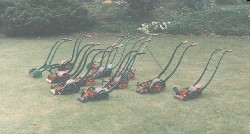
By 1852 Ferrabee had made improvements to the original Budding design and added two more sizes, a 30in and a 36in machine. By now they had sold upwards of 4,000 machines. In their advertisements for 1852 they stated that only mowers marked Budding were guaranteed a suggestion of competition from a new source. In fact what happened was that the Patent Office had started to allow lawn mower improvements in design to be patented and this opened up the field to others. The first patented improvement was that of Samuel Boyd in 1854. The company which manufactured the machine were Samuelson of Banbury, agricultural implement makers. The mower designed was on the same principle as Budding except that it was lighter in draught and easier.
In 1855 a new contender, Thomas Green of Leeds, entered the field of lawn mower manufacturers. Thomas Green was a blacksmith and maker of wrought iron gates who that year designed a machine which could be drawn from behind (in fact Shanks sold the same design in August 1856). Green made improvements on the Budding design by reducing its weight by one third and added a rake to lift the grass before it was cut. This mower was produced in a wide range of sizes from the smallest of 8in to the largest at 42in. A 48in model was tried but it was found that too much flex and wear on the gears made it impracticable.
The first lawn mower trial took place in the London Horticultural Gardens at Chiswick in 1858. The trial area was at the side of the arboretum and plots were drawn of equal size. The entrants were Shanks, Ferrabee, Samuelson and Green. They all brought machines of 22in width, excepting for Green whose machine was a 24in model. Green's machine was judged the best with Shanks and Ferrabee runners up. Samuelson was placed last, having received a poor write up because the gears kept clogging. That same year, after selling some 1,500 machines, Ransomes stopped producing the Budding mowers. Instead they became wholesalers for Thomas Green and Shanks. The following year Ferrabee's son James took over the engineering works and made improvements to the Budding design.

Thomas Green patented the first lawn mower to be driven by chains, a fundamental development because chain drive meant a lighter machine. He named this machine the Silens Messor which implies silent running. Although the Silens Messor range altered shape over the years the fundamental principles did not and the range was to become the backbone to Thomas Green's business until production finally ended in 1935.
In 1861 Ransomes re-entered the lawn mower market with their now improved machine. Although still resembling the Budding machine, it was shown at the International Exhibition of 1862 along with Shanks, Ferrabee and Green. In fact Green had an enormous stand at the exhibition and managed to win most of the medals on offer. The International Exhibition created interest from new companies who started to produce their own style of mowers. Morton's Patent, by Grimmond Laird of Arbroath, Scotland, appeared in 1863 but was short-lived as there was no real improvement to that already on offer. From 1864 most manufacturers had left behind the predominant style of the Budding machine.

The land rollers had reduced in diameter, the material for the castings had altered because by now most companies were using cast iron. Cast iron was found to be a vast improvement because, when molten, it could be poured into a cast, enabling the most intricate shapes to be produced. In 1864 Barnard, Bishop & Barnard invented a new style of drive whereby instead of a chain or gear drive, three rubber tyred wheels, of different diameters were used. As the mower was pushed along, the wheels turned by friction. This idea, however, was not successful and by 1866 a return to gear-drive had been made.
Ransomes in 1867 introduced a totally new design of mower, the Automaton which became an instant success with over 1,000 machines being sold in the first season. This design was to put Ransomes level with the other two main producers, Shanks and Green.
Follows and Bates entered the market in 1869 with a mower called the Climax. This machine was a major innovation - the land roller was removed and replaced by two land wheels placed on the outside of the side-frames. A gear inside the land wheel drove the cutting cylinder. This meant that the machine had fewer parts and therefore was much lighter. It also meant a reduction in costs. By 1871 Follows and Bates had sold over 4,000 of these machines. But regular maintenance was required to keep the knives sharp. Thomas Green's idea was to have a reversible cutting cylinder which could be alternated to produce even wear. Ransomes devised a clever system whereby one of the wooden handle grips would unscrew and placed in a special hole in one of the side gears. The handle could then be used to turn the gear backwards making the cutting cylinder rotate in reverse. By placing flowers of emery on the edge of the knives the cylinder could be ground in. Alternatively, special sharpening tools were devised in which the cutting cylinder was removed from the mower and placed on a machine bed and ground. Ransomes also developed an early machine for just this purpose.